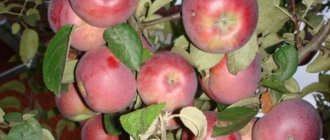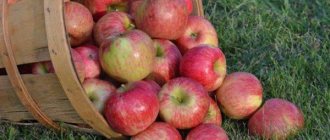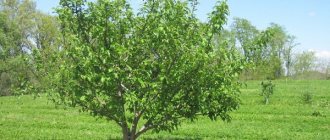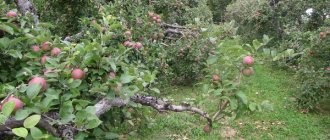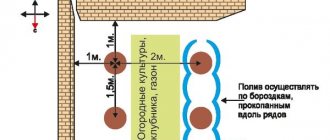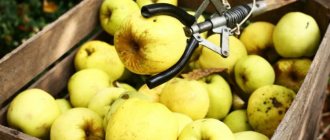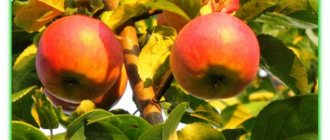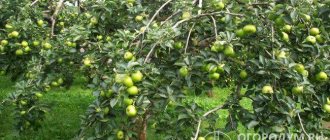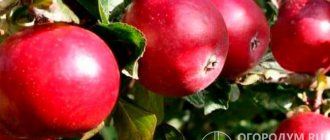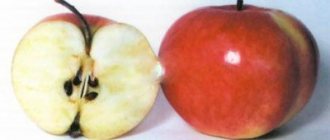Gardening » Apple tree
0
505
Article rating
Kira Stoletova
Dwarf apple trees for the Moscow region are represented by several groups with different periods of fruit ripening. The unique features of these varieties include early ripening, good winter hardiness and compact crown, which makes it possible to grow several trees at once in a small area.
Varieties of dwarf apple trees for the Moscow region
Various dwarf apple varieties for the Moscow region
Dwarf trees (as well as semi-dwarf varieties) are good to plant if you have a small plot of land. In addition, such trees, despite their small size, produce high yields and are highly resistant to diseases.
This must be taken into account when selecting trees for cultivation.
Dwarfs have some advantages compared to ordinary ones:
- Their height is 2-4 m and they have a crown up to 2 m in diameter. Because of this, they can be placed even in a small area.
- The fruits are very easy to pick as the trees are not tall.
- All dwarf apple trees bear fruit annually, unlike ordinary varieties.
But varieties of low-growing apple trees also have a drawback - trees need to be replaced much more often , since their lifespan is shorter than that of ordinary ones.
They also need to be covered more thoroughly for the winter, because... The root system is located shallow underground and can freeze.
Comments (2)
Ira
10/07/2018 at 00:34 |
I wonder, when the fruits on these small apple trees ripen and grow, will the branches not break under the weight of these apples? The trees seem so weak to me that they will not be able to withstand this load.Answer
Yulia Expert Plodogorod
09.10.2018 at 19:21 |
Hello, Ira. Even the best varieties of low-growing apple trees can have branches that break and fruits fall off if you do not follow the rules of caring for them.
In order to protect the branches of your apple trees, you can use several options. The first is to install special supports. Usually one main rod is used near the trunk and additional ones under the fruit shoots. They have a branch at the end, on which the branch is laid. If necessary, it is secured with a rope.
When pruning a tree in spring or autumn, it is important to form the crown correctly. Avoid growing shoots at an acute angle. In this case, it will be heavier for the plant.
You can also remove some apples at the flowering stage. This will mechanically reduce the load. Of course, the harvest will not be as abundant, but there is no risk that the tree or its branches will begin to crack and break. In addition, the remaining apples will ripen larger. This is especially appropriate for young plants that are not fully mature.
Answer
Dwarf apple tree varieties for the Moscow region
Summer
Melba
Fruits are set on the trees for the 3rd year after planting the seedlings; they are harvested from July 25th. are collected from one tree. They are of medium size, their weight is 150-250 g. They are round in shape, slightly elongated. The main color is lime color; they may have yellow stripes. The cover color is blush. The pulp is white, tender, with a caramel flavor. They can be stored for 3 months.
Read more about the Melba apple tree here.
Candy
The fruits are slightly smaller than average, weighing 120-130 g. They are round, non-shiny, dark green. The pulp is dense, contains a lot of juice, and has an amazing aroma .
The fruits are harvested from August 1st.
You can read more about the Candy variety here.
Autumn
Zhigulevskoe
The trees begin to produce apples for 3-4 years. They ripen at the end of September. They are very large in size , weighing up to 350 g. They are round, slightly flattened along the axis. The color of the fruits is golden-red. The pulp is juicy, sweet and sour, the grains are large.
The variety is the most resistant to diseases and pests among all autumn fruiting varieties. But frost resistance is not too high, which is why apple trees are carefully wrapped in spunbond for the winter.
More information about the Zhigulevskoye apple tree variety in this article.
Autumn striped (Streifling)
The fruits are large, their weight is 150-200 g. They are spherical, slightly elongated. They are bright green in color and have vertical stripes. The taste is richly sweet and sour.
Apple trees are not very winter-hardy , since their roots are close to the surface. Therefore, for the winter, the tree trunk circle is mulched with horse humus, cow manure, and the apple trees themselves are wrapped in spunbond; it is also necessary to cover the crown for the winter. The fruits can be collected in September.
More information about the Autumn Striped apple tree here.
Glory to the Winners
The fruits can grow both medium and large. Their weight is 120-180 g. The main color is greenish-yellow, the top color is scarlet blush. The pulp is creamy-white, sweet-sour, juicy, tender.
In the Moscow region, apples ripen by early September.
Read more about the Glory to the Winners apple tree here.
Winter
Grushovka Moskovskaya
This is an old and very famous variety. Has immunity to diseases. The tree bears fruits after 5-6 years. They produce apples every year, there are quite a lot of them, however, the fruits do not ripen at the same time. But the fruits themselves are small, their weight is 80 g. The shape is round and elongated.
The main color is canary. The top color is the blush on the side of the fruit that was illuminated by the sun. The pulp is sweet, sour, and very aromatic.
More information about the Grushevka Moskovskaya apple tree variety in this article.
Bogatyr
Trees bear fruit for 5-6 years. This dwarf apple tree grows very intensively , which is why it needs to be pruned every year. Pruning, among other things, increases the amount of harvest. But these short apple trees are the most frost-resistant among winter varieties, they are immune to diseases , and are almost not affected by insect pests.
They produce small apples weighing up to 80 g. They are round and somewhat flattened in shape. Yellowish-red in color.
The taste is sour, reminiscent of the taste of Antonovka. Apples can be stored for a very long time - 9 months.
You can read more about the Bogatyr variety here.
Summer
This selection contains low-growing apple trees for the Moscow region, which ripen at the end of summer and are practically not stored. But these hybrids are for the most part unpretentious and can be grown in different regions. A short warm season is enough for them to ripen.
Melba
The short growth of an apple tree does not in any way affect its fertility and quality of fruits. The apples are medium-sized, sometimes even large. Their shade is lemon green, with a slight red blush. A special feature is the pulp of the fruit: very tasty, with a caramel flavor. The tree is not self-pollinating and needs neighbors flowering at the same time. The fruits last a long time, by the standards of summer varieties, up to 100 days.
Apple tree Melba.
Candy
The variety is high-yielding and unpretentious, produces a large amount of tasty fruit. The fruits are small, sometimes slightly smaller than average size. Their shape is correct, the skin is light and they have a surprisingly pleasant apple aroma. Harvesting usually occurs in early August, but fruiting may be delayed due to unfavorable weather conditions.
Apple tree variety Candy.
The president
The small tree can be grown as a columnar species. There is not a lot of fruit, maybe up to 25 kg, but the apples are tasty and large. The variety is unpretentious and does not need special treatment. Not afraid even of return frosts.
Columnar apple tree President.
Rating of varieties
According to tasting assessment of fruits
According to their taste, apples of the Confectionery and Melba varieties are the sweetest , and Melba fruits also have a caramel flavor.
And reviews of the fruits of the Bogatyr variety say that they are the most sour.
Resistance to diseases and pests
Among the varieties grown in the Moscow region, the most resistant to diseases and insect pests are considered (you could see their photos and descriptions above):
- Zhigulevskoe;
- Bogatyr;
- Grushovka Moskovskaya.
According to winter hardiness
The most winter-hardy varieties of dwarf apple trees for the Moscow region are the dwarf apple tree Bogatyr.
By fruit size
This is the Autumn Striped variety .
What to look for when choosing an apple tree variety
The main qualities for successful cultivation of a variety are:
- drought resistance,
- frost resistance,
- resistance to diseases and pests.
And also, when selecting varieties according to ripening time, it is advisable to plant apple trees so that they produce a harvest all season long, and the fruits are kept fresh for a long time in the cold winter, when there are so few vitamins. That's what apple trees are for:
- summer,
- autumn and
- winter ripening periods.
Let's consider the best varieties of apple trees for the Moscow region and other regions of the Russian central zone.
Columnar apple trees cultivated in the Moscow region
Dwarf apple trees are low trees with a spreading crown reaching 3 m in diameter. Apple trees on a semi-dwarf rootstock are slightly taller than dwarfs.
And columnar apple trees have a trunk on which short side branches grow. The tree trunk is like a column with apples growing on top and along it.
To avoid confusing a dwarf apple tree with a columnar apple tree when purchasing, remember that:
- A columnar tree has one trunk, without a crown;
- The dwarf apple tree has fibrous roots, while the columnar apple tree has rod-shaped roots.
What is rootstock for an apple tree?
The rootstock is the part of the plant located under the graft, that is, the entire root system and part of the trunk. The famous domestic scientist breeder I.V. Michurin called the rootstock the fundamental basis of the plant.
Please note! The quality of the rootstock will determine the strength of growth, the beginning of fruiting, as well as cold resistance and resistance to diseases and pests, that is, almost all the individual characteristics of the tree.
Planting and caring for such apple tree “curiosities” is somewhat different from the classics.
Rootstock for apple trees has a list of advantages, and this is the reason for its popularity in recent times:
- trees begin to bear fruit after 2-3 years;
- the height of an adult tree does not exceed 2-2.5 m, low-growing;
- the root system of apples readily responds to watering and fertilizing;
- due to their short stature, the fruits do not break when falling to the ground, which greatly simplifies the harvesting process;
- due to good illumination of any part of the tree crown, a high concentration of ascorbic acid and sugars accumulates in apples;
- Apple trees on a dwarf rootstock are not afraid of the proximity of groundwater to the surface of the earth and are unpretentious to the composition of the soil.
However, we should not forget about the disadvantages, which, unfortunately, also exist:
- shorter tree lifespan;
- some varieties of low-growing rootstocks are characterized by poor frost resistance;
- there is a predisposition to overload with the harvest, which leads to crushing of the fruits and deterioration in their quality.
Low-growing apple trees for the Moscow region
This variety of apple trees belongs to the early-fruiting variety, since it begins to fully bear fruit already in the 3rd year after planting the seedlings. Another remarkable feature of this variety is its dwarf trees. Our apple trees are 6 years old, but they have grown only 2 meters in height. Harvesting is very convenient. Pruning and supports are definitely necessary - the trees have a high yield and branches can break under the weight of the fruit. It tolerates frosts very well. Here in the Lipetsk region they reach 30-35, but these trees winter safely all years. This variety also tolerates dry summers well, but to get a good harvest, I make sure to water the trees. I do this at least once.
I like the Moscow Necklace variety. We have planted a whole hundred of them! The only thing that is necessary is to trim the side branches that are too elongated and to cover the trunks from rodents for the winter. That's it, then just watering and fertilizing. The holes for the apple trees were not dug too deep, but they were filled with rotted manure and fertilizers were sprinkled. It was in the spring, five years ago. Planting pattern: meter - by meter. The top must be pinched immediately. The trunks were whitened and the apple trees were observed during the summer. The first year they were attacked by all and sundry: aphids and codling moths, spider mites and ants. I had to spray it with Fitoferm, then a month later again with Aktara. The apple trees also defeated the pests.
Grushovka Moscow is famous for its frost resistance. This is probably why it is so often found in our gardens in the Moscow region. It can withstand even severe frosts in winter with dignity. The variety is called this way not because it has a pear taste, but because of its pear-shaped crown. The pulp is a little reminiscent of pear pulp, it is just as loose and yellowish in color. When planting seedlings, I advise you to pay attention to the windiness of the area - it is important that it is not open and protected from the wind. This variety of apple tree, like many others, requires careful care: watering in the evening in the summer, not only in dry weather, pruning and shaping the crown, fertilizing with fertilizers and mandatory whitewashing. Having done these.
I want to say a few good words about the glorious apple tree “Lungwort”. How sweet and tasty it is, just a joy for a summer resident! There is nothing tastier than an apple from your own garden! And Lungwort also has a pleasant, aromatic taste, reminiscent of honey. Caring for an apple tree is no different from caring for all other plantings in the garden. Also necessary are sanitary pruning (we do this only in the spring), spraying against pests, various fertilizing with fertilizers and watering in the heat. In late autumn we wrap the trunk against rodents. We rake up all the remaining leaves under the crown and burn them. I think this apple tree is suitable for everyone.
Apple tree rating
By sweetness
As one of the options:
- Winter lungwort;
- Scarlet anise;
- Anise gray;
- Aport;
- Alexander;
- Peaceful;
- Rososhansky striped;
- Gift to Grafsky.
In terms of sweetness, many people prefer Dessert Isaev and Winter Lungwort.
For resistance to scab and other diseases
For yourself, you should already note that one often finds in the characteristics of the advantages of apple trees is their resistance to such a dangerous disease as scab. And for good reason:
- After all, apples affected by scab cannot be sold;
- And it’s unpleasant to eat by yourself.
Scab on an apple tree.
So they even create varieties that are immune to such a disease. Employees of the Oryol Research Institute specialize in the following varieties:
- Imrus;
- Venyaminovskoe;
- Bolotovskoe;
- Freshness;
- Rozhdestvenskoe;
- Memory of Semakin;
- Good news;
- Orlik. And others.
Dwarf apple trees for the Moscow region - which variety to choose
Dwarf apple trees are far from new; they have been grown for a long time and enjoy the well-deserved love of gardeners. The trees are more compact, grow up to 2.5 meters, require less space, and are unpretentious. They calmly tolerate high groundwater levels. Their lifespan and fruiting period are shorter, about 15-20 years, with the first apples appearing already in 2-3 years. Let's consider which low-growing varieties are more suitable for the Moscow region and why?
Dwarf apple trees for the Moscow region
How to choose a variety
The first question that arises for a novice gardener is: “Which varieties of apple trees are dwarf and which are not?” And here a detailed explanation is needed.
The fact is that absolutely any variety of apple can be grown on a dwarf rootstock. That is, having a special rootstock, the gardener grafts his favorite variety onto it, and enjoys the taste of the fruit and the small dimensions of the tree itself.
At the same time, in modern breeding there are already about ten thousand dwarf varieties of apple trees, which, when planted by the root method, will not grow more than one or two or three meters (the height depends on the variety).
Attention! Gardeners must understand that breeding dwarf varieties and producing such seedlings is not an easy and rather labor-intensive task. Therefore, the cost of rooted dwarf apple tree seedlings will be many times higher than usual.
Those who have no experience in grafting usually purchase varietal or natural dwarfs. Experienced gardeners can easily plant a special dwarf or semi-dwarf rootstock, and then graft any apple tree onto it.
Varietal "dwarfs"
The description of varieties of natural dwarf apple trees should begin with their classification. Like all other crops, they are divided according to the timing of apple ripening: early ripening (summer), mid-ripening (autumn) and late ripening (winter).
Among them there are sweet varieties of dwarf apple trees, sweet and sour, sour - that is, the taste of the fruit has the same classification as that of ordinary tall apple trees.
Attention! It is customary to classify frost-resistant varieties into a separate group, but, as already mentioned, due to the characteristics of the root system, this characteristic is approximately the same for all “dwarfs”.
Melba
One of the most productive dwarf varieties. This apple tree usually grows no more than three meters in height. The apples themselves are round, slightly elongated, colored green, with blush visible on one side. The fruits are medium in size, weighing 200-250 grams.
Melba is a summer variety; apples ripen in early August. Their flesh is juicy, tender, and very tasty. The fruits can be stored for a maximum of three months.
The winter hardiness of the dwarf apple tree is average; it is better to insulate the roots. The yield is up to 40 kg per plant.
Wonderful
The “dwarf”, common in Russia, grows to a maximum of 280 cm. The fruits weigh about 150 grams, are yellow, round, with noticeable ribbing and a crimson blush. The taste of apples is sweet and sour, the flesh is fine-grained and juicy.
The dwarf apple tree bears fruit in late summer - early autumn. Apples of the Wonderful variety are stored for about two months. From each tree you can collect up to 75 kg of fruit.
The dwarf variety has very good resistance to scab and tolerates severe frosts without shelter.
Attention! The dwarf apple tree Chudnoye is the best pollinator for any “dwarfs”. Anis Sverdlovsky is most suitable for the role of pollinator for the Wonderful One.
Zhigulevskoe
This dwarf variety is an autumn apple tree with good yield. The tree grows up to two to three meters and can produce about 120 kg of apples per season.
The fruits are round, colored coral-red, and quite large - the average weight is 230 grams. The pulp is juicy, coarse-grained, tender, and tastes sweet and sour. The fruits are stored for about six months.
The Zhigulevsky apple has good resistance to pests, diseases, and frost.
Bratchud
Short name for "Brother Wonderful", another natural (or natural) "dwarf". This dwarf apple tree is suitable for growing in any climate and on almost any soil. The crown of the tree is rounded and flat, it grows up to two meters.
The apples are medium-sized, greenish-yellow with a crimson blush. A distinctive feature of the fruit is a stripe-seam on the peel. The pulp is white, pleasant to the taste, not very juicy. But the Bratchud variety is very productive, the fruits tolerate transportation well and are suitable for storage.
Carpet
An autumn variety of dwarf apple trees, the tree reaches a height of 1.5-2 meters, its crown is drooping. Kovrovoe begins to bear fruit in the third or fourth year after planting.
The fruits are large, greenish-yellow, with a ruddy side. The pulp is cream-colored, not very juicy, pleasant to the taste, sweet and sour, aromatic. The harvest can be stored for up to two months.
The variety is very productive and tolerates frost well. In very snowy winters, the horizontally located lower branches of a dwarf apple tree may break off.
Legend
The variety is considered an early winter variety - the fruits ripen in early October. The crown of the dwarf apple tree is spherical, the height of the tree is a maximum of three meters. The shoots are short, heavily leafy.
The fruits are slightly ribbed, large, and have the shape of a truncated cone. When ripe, apples are red in color. The pulp is white, juicy, with a strong aroma and a very pleasant taste.
The dwarf variety Legend is resistant to diseases and pests and has good winter hardiness.
Moscow red
A very productive winter variety of dwarf apple trees. The tree is compact (maximum height is three meters), its crown has the shape of a ball.
The fruits are round, smooth, shiny. When ripe, the apples are colored a rich yellow color, with a red blush on the side of the apple. The taste is good, sweet and sour, the aroma is strong. Apples can be stored for up to four months.
The Moscow Red variety resists scab and other diseases very well - the leaves and fruits always look beautiful and healthy.
Summer varieties
Dwarf and semi-dwarf apple trees have a number of advantages, among which gardeners consider the most important:
- small sizes;
- natural crown formation;
- ease of care and harvesting;
- stability of fruiting without long breaks;
- unpretentiousness to the place of growth.
The only significant drawback is the short life of the tree; it is unlikely to be passed on by inheritance. After 15-20 years, it will have to be replaced with a younger one, even with strict adherence to the rules of care.
Early ripening hybrids are considered summer.
Melba
The variety was bred in Canada and bears the name of the opera singer. Designed for mid-latitude climates, tolerates frost well and quickly adapts when transplanted.
The height of an adult tree reaches 2 m; at first the crown is columnar, then acquires a rounded shape.
The apple tree needs pollinators. Borovinka and Suislepskoye are best suited.
The first harvest is obtained in the 4th year, life expectancy is about 13-15 years. Flowering - from April to early May, fruit ripening in August.
During early flowering, in 2-3 years, it is recommended to remove the buds to strengthen the root system.
The apples are medium in size, up to 160 g, green in color with red stripes. Shelf life: 3-4 months in a cool, dark place.
From 10 to 15 kg of fruit are obtained from a tree, the yield is increasing. By the age of 10, it begins to decrease.
Candy
The name was received for the traditionally small fruits with a sweet and sour taste and a bright smell reminiscent of honey. The author of the variety was the breeder S.I. Isaeva, who also bred Northern Sinap and Memory of Michurin.
The apple tree is intended for non-chernozem regions with long winters with little snow.
It is resistant to the vagaries of nature, has a high immunity to fungal diseases, including scab.
On a dwarf rootstock, the height is about 2.5 m, the crown circumference does not exceed 1.5 m, and requires sanitary and shaping pruning. Grows well on light soils, does not tolerate shaded and marshy areas.
Lifespan is 18-20 years. The crop is partially self-fertile; when adjacent to varieties of the same flowering period, the number of ovaries increases. Pollinators can be:
- Anise pink-striped;
- Yandykovskoe;
- Melba;
- Padding.
Fruiting time is from mid-August. The yield of an adult tree is 14-20 kg.
The size of the apples is about 120-130 g, greenish-pink in color. The pulp is dense and juicy.
The disadvantage is considered to be severe damage to the fruit by wasps and poor tolerance to transportation. It is more profitable to process them immediately after harvesting: they are perfect for making juice, preserves, jam, compotes, and marmalade.
The president
Productivity increases every year
The variety was obtained by breeder V.V. Kichin more than 40 years ago. It tolerates long, harsh winters with frosts down to -30-35°.
The fruits are large, weight reaches 200 g. The shape is flattened, turnip-shaped, the skin is green, the flesh is dense, white, juicy.
5-7 kg are removed from a young plant, and every year the yield increases, reaching 15-20 kg.
Semi-dwarf tree (up to 2-2.5 m in height, compact crown, with short fruiting branches, powerful root system, which ensures rapid adaptation after transplantation. Life span up to 15 years.
It is worth considering: the variety has a good ability to form ovaries even in the absence of pollinators.
- The advantages include high immunity to disease, early onset of fruiting, compact crown size, and high yield.
- The disadvantages are that they are demanding on the planting site and the inability of the fruits to be stored and transported for long periods of time.
Advantages of low-growing varieties
The popularity of dwarf apple trees among gardeners is ensured by a number of advantageous differences from trees of standard height:
- Easy to care for. One of the main advantages. For the first few years, you can care for the tree without any additional stands, standing on the ground. When the tree grows to its full height, in order to reach the upper branches, you only need a small indoor stepladder. This makes it much easier to thin out the crown, monitor excess branches, and pinch shoots. Spraying trees with a garden sprayer is also easy.
- Fast harvesting. Removing fruits from tall trees is quite problematic. Various devices appear - stands, ladders, collection cups with sharp edges mounted on a stick. All this can be avoided if you choose a dwarf apple tree for breeding.
- Having planted a young tree, people wait for the harvest in about the 5th year. Diseases or unfavorable circumstances can delay a bountiful harvest for some time. Dwarf varieties, due to their smaller size and rapid metabolism, begin to bear fruit after three years.
- The best properties of the fruit. On small trees they turn out surprisingly large, juicy and ripen well. One of the reasons is a thinner crown, which allows sunlight to easily penetrate the ovaries and growing apples.
- Higher yield. For dwarf varieties, the number of apples collected per season from one square occupied area will be greater than for standard ones.
- Tight fit. Thanks to its compact size, even a small area can be quite densely planted with trees, given that the distance between the holes should be at least two meters.
Autumn varieties
Low-growing apple trees on a dwarf rootstock are considered autumn if their fruiting period falls in mid-September and October.
Such fruits are already suitable for long-term storage; the skin of most of them is dense, which makes transportation over long distances possible.
An excellent option for small areas, since the height of the apple tree is 2 m, its shape is columnar and it can be planted at a distance of 0.8 m from the neighboring tree.
The variety takes root well in regions with harsh winters, provided pre-winter preparation is carried out.
Characterized by early fruiting. The first ovaries appear already in the second year after planting. Productivity increases every year, starting from 4-5 kg and gradually reaching 20 kg per tree.
The fruits are bright red, arranged several in a rosette, weighing from 160 to 200 g. They can be stored for 6 months. The variety is resistant to scab and other fungal diseases, and is unpretentious to the composition of the soil.
The planting site must be chosen at an elevation, away from groundwater, otherwise the lifespan will be reduced from 15 to 4-5 years.
Important: there are periods of dormancy when the tree produces only 7-8 fruits per year, restoring its strength. Next season we can expect a sharp increase in yield.
Streifling
It is often called Autumn Striped because of the color of the fruit.
The apples grow small, up to 190-200 g. The taste is sweet with a slight pleasant sourness.
Apple tree Wonderful
| Entry into fruiting | Tree height (m) | Fruit weight (g) | Harvest | Shelf life (days) |
| For 2-3 years | 1,5-2 | 140-200 | Early August | 25-30 |
The late summer variety Chudnoye is recognized as the best pollinator for all “dwarfs”. For him, it is recommended to plant Anise Sverdlovsky as a pollinator. The variety has good resistance to scab and tolerates frosty winters without problems, suitable for cultivation in all zones of Russia.
The tree is low-growing (natural “dwarf”), the crown is formed in a horizontal plane, almost spreading along the ground. The fruits are large, larger than average in size, some weigh up to 200 g. The shape of the apples is flat and round, the main color is yellow-green, and as they ripen, a rich bright red blush appears.
The fruit pulp is juicy, with a fine-grained structure, sweet and sour taste, with a pleasant aftertaste. Sweet desserts are prepared from them: jams, preserves, compotes, juices, mousses, etc. Apples can be stored for up to a month, which is unusual for early varieties.
Winter varieties
Late ripening fruits do not immediately reveal their taste qualities. To achieve full ripeness, they need to rest for 1-2 months.
They are stored almost until the new harvest, subject to the temperature schedule and optimal humidity indicators.
Grushovka
The variety has been tested by time, has its long-time fans, is distinguished by high productivity, excellent characteristics in transportation and storage.
Fruiting begins in the 5th year, the apples are small, oval, and green at technical ripeness. In the process, they acquire a yellowish tint and a pronounced fruity aroma.
Moscow necklace
The tree grows up to 2.3 m, the crown is compact and does not require additional pruning. The branches are formed horizontally, which is very convenient when harvesting.
It bears fruit annually at the end of October. The fruits are small, spectacular burgundy in color with a slight waxy coating. The skin is dense, the flesh is juicy. The harvest can be stored for 5-6 months.
The apple tree withstands long-term frosts and temperature changes, and forms an abundant ovary.
Bogatyr
Despite the name, the fruits are small. Bogatyrsky can be called the health of a tree, its resistance to adverse weather conditions, diseases and pests. A very valuable quality is the ability of apples for long-term storage and long-distance transportation, up to 9 months.
The tree requires constant formative pruning. To avoid thickening of the crown, it will have to be shortened annually by a third of the length of the branches.
Variety Bogatyr must be pruned regularly
Benefits include:
- high productivity;
- resistance to typical diseases, including scab;
- quick adaptation when landing;
- winter hardiness.
Apple trees are often used as a pollinator for other varieties. Popular winter varieties also include Bolero and Arbat.
Caring for dwarf apple trees in the garden
How to care in spring
Growing dwarf apple trees is much easier than regular ones, you just need to know some of their features. In early spring, the branches of newly planted trees should be slightly shortened; in older trees, formative and sanitary pruning should be done. Before sap flow begins, trees are treated preventively against diseases and pests and trapping belts for harmful insects are attached to the trunks.
Since the root system of this form of apple tree is superficial, the soil in the tree trunk circles should not be allowed to dry out, so carefully monitor its condition. After watering, you need to loosen the soil in the tree trunk circles to a depth of 5-7 cm. It is in order to prevent moisture from quickly evaporating from the soil that gardeners usually mulch the tree trunk circles.
And don’t forget to whitewash the trunks and bases of skeletal branches with lime in April in good weather. In spring, dwarf apple trees are fed with nitrogen or complex fertilizers.
How to grow in summer
Caring for a dwarf apple tree in summer means, first of all, monitoring the soil moisture in the tree trunks. At this time of year, the fight against harmful insects, which is carried out with folk remedies or specially developed chemicals, also becomes relevant. Fertilizing in the summer is carried out mainly by foliar methods, adding microelements to the fertilizer solution, in particular iron, which apple trees usually lack.
When the apples begin to fill, take care of supports for branches weighed down with fruits.
- Marjoram: growing in the garden, properties, varieties
Autumn care rules
Most varieties of dwarf apple trees ripen in the fall, so the main task will be to harvest apples. Keep tree trunk areas clean - regularly remove carrion and other debris. After harvesting, apple trees are fed with mineral fertilizers and pruned for sanitary purposes. The soil in the tree trunk circles is cleared of plant debris - fallen leaves and branch cuttings, after which it is loosened to disrupt the thermal insulation of insect pests that have settled in for the winter.
In mid-autumn, preventive treatment of trees against diseases and pests is carried out. Late autumn is the time to prepare dwarf apple trees for winter.
Processing dwarf apple trees
In the spring, before the buds swell, dwarf apple trees are sprayed with a one percent solution of Bordeaux mixture or Nitrafen against pests and fungi that have successfully overwintered in the tree bark or in the top layer of soil. You can treat apple trees with a seven percent urea solution - both against pests and insects, and as a nitrogen supplement. It is very important that the treatment is carried out before the sap begins to flow, otherwise the opening buds may get burned.
In the fall, after leaf fall, while preparing the garden for winter, autumn preventive treatment of dwarf apple trees is carried out with a one percent solution of Bordeaux mixture or Nitrafen.
Watering
The watering schedule for apple trees is adjusted to the weather and age of the trees. Apple trees that have not yet begun to bear fruit are watered three times a year at the rate of five buckets of water per tree, with the last watering being carried out in early August. Fruit-bearing apple trees are watered more often, 3-5 times a year - before flowering begins, during it, before the ovaries fall off (in June) and before the fruits begin to ripen. If trees grow on sandy loam soil, each tree will need 4 buckets of water, and if on loamy soil, then 6 buckets.
If the summer is dry and the autumn without rain, then it is necessary to carry out pre-winter moisture-recharging watering of dwarf apple trees in order to wet the soil to the depth of the roots. This will require 10 liters of water per 1 m² of garden. Pre-winter irrigation is not carried out in areas with high groundwater levels.
Top dressing
Since the volume of the root system of dwarf apple trees is small, and fruiting is abundant, it is necessary to regularly fertilize the trees with fertilizers - once every two weeks. In the second and third years, each apple tree is fertilized with a solution of 30-40 g of complex fertilizer in a bucket of water. At least twice a season, you can feed a dwarf apple tree with a solution of mullein (1:10) or chicken manure (1:20) at the rate of one bucket of solution per tree.
In the summer, complex foliar feeding of apple trees is carried out with mineral fertilizers, in which the leaves must be sprayed with a nutrient solution on both sides. This should be done in dry, windless weather early in the morning or late in the evening. Foliar feeding of apple trees with urea gives good results, but you need to know that the solution should be of a consistency that will not leave burns on the leaves of the tree. The last foliar feeding is carried out no later than September.
In autumn, nitrogen is not included in fertilizing, since it, by stimulating the growth of new shoots, delays the preparation of plants for winter. At this time of year, apple trees need potassium and phosphorus. Here is an approximate recipe for feeding 1 m² of garden: dissolve 1 tablespoon of potassium and 2 tablespoons of double superphosphate in 10 liters of water.
Wintering a dwarf apple tree
Since the root system of dwarf apple trees is superficial, it can freeze out during frosty, snowless winters. To prevent this from happening, cover the trunk circle of the apple tree with a thick layer of humus or compost, and lay spruce branches on top. If snow falls, you can remove the spruce branches and add a snowdrift to the tree trunk circle - under the snow, dwarf apple trees are not afraid of any frost.
Features of cultivation
To successfully grow a dwarf or semi-dwarf apple tree, you need high-quality planting material.
You can try to vaccinate wild animals yourself. A less labor-intensive and more reliable way is to purchase a seedling from a nursery or gardening center.
The average price for a one-year-old tree will be from 150 to 400 rubles.
One-year-olds take root best.
The optimal planting dates are considered to be the beginning of May and the first days of September.
Before purchasing a plant, you need to make sure that:
- the root system is well developed and carefully protected from drying out;
- there is no damage or peeling on the trunk bark;
- The branches are flexible, without breaks.
It is worth considering: it is better to buy planting material on the day of planting or the day before.
Features of "dwarfs"
All experienced gardeners know the fact that ordinary varieties of apple trees are obtained by grafting to a rootstock grown from a seed or from a cutting of a varietal crop.
To grow a dwarf tree, it is necessary to graft a varietal cutting onto a special dwarf or semi-dwarf rootstock. Attention! Currently, Russian gardeners prefer to do such grafting on apple tree rootstock b7-35 or m9.
Seedlings of dwarf varieties are sold everywhere, but they are somewhat more expensive than ordinary tall trees. In order not to purchase a “fake”, you need to know the characteristic features of dwarf apple varieties:
- there is always a clearly visible protrusion near the root collar of the “dwarf” - this is the grafting site;
- the root system of simple apple trees has a tap structure, while the roots of the dwarf variety are fibrous, small, and well branched;
- two-year-old dwarf apple tree seedlings should have large buds located at the ends of the shoots;
- the standard should have a height of no more than half a meter;
- There should be few formed branches, just a few pieces.
Important! Inexperienced gardeners may confuse seedlings of columnar apple trees with “dwarfs”. A feature of the columnar tree is a thick, even trunk and an almost complete absence of branches.
Advantages and disadvantages
Reviews from gardeners about the dwarf apple trees that exist today are contradictory: not everyone likes the features of these trees. In order not to be among those disappointed, you need to carefully study all the information about “dwarfs” and know their pros and cons.
All varieties of dwarf apple trees have several common qualities: among them there are both positive and negative characteristics. A gardener who decides to plant a dwarf tree should know about its advantages:
- Compact dimensions of the crown and root system. For normal development, a “dwarf” only needs a couple of square meters of garden. This small tree will not cast a shadow on the site or vegetable beds, and its roots will definitely not harm the foundation of the house or other outbuildings.
- The dwarf apple tree begins to bear fruit very early - already in the third year after planting, full harvests can be harvested. But ordinary varieties begin to bear fruit consistently only in the sixth or seventh year.
- The yield of “dwarfs” is comparable to the number of fruits of a standard adult apple tree. Every year the yield of dwarf apple trees increases; the tree does not slowly age.
- Caring for a dwarf apple tree, harvesting from it, pruning and spraying is much easier, because the branches of the tree are at human eye level. The gardener will not need ladders, stepladders or other special equipment.
- The crown of the “dwarf” is small, so the branches and leaves need very little nutrition. All nutrients and moisture from the soil go directly to the fruit, which significantly affects the taste and size of the apples.
- The trunk of the dwarf apple tree is short, all substances move quickly along it, and the roots located close to the surface immediately absorb water and fertilizers from the soil. This structure allows the fetus to quickly and fully receive the necessary nutrition.
- Significantly less fertilizers and means for treating the crown will be needed than in the case of tall apple trees.
- The bark of “dwarfs” is thinner; the tree stops growth and development earlier with the onset of cold weather. Therefore, compact apple trees have time to prepare for wintering, as a result of which they rarely freeze out. Winter-hardy dwarfs are increasingly becoming the choice of gardeners from the Urals and Siberia.
Advice! The branched surface roots of the “dwarfs” allow them to be planted where ordinary trees would probably die: unfavorable soils, nearby groundwater. Thanks to this quality, it is possible to plant an orchard where nothing has grown before.
Unfortunately, dwarf varieties also have disadvantages:
- Short lifespan. Unlike ordinary varieties, which can bear fruit for up to forty years, “dwarfs” live only 15-20. But in this period you can collect as many apples as an adult tree would produce in half a century. In addition, the gardener will be able to change the varieties of apples on his plot more often.
- In conditions of little snow but frosty winter, roots located close to the surface may freeze. To prevent this from happening, the soil around the “dwarf” trunk is insulated, mulched or covered with agrofibre.
- Since short roots will not be able to get food from the depths of the earth, the dwarf apple tree will have to be watered more often and better fertilized.
- A lot of ovaries are formed on the “dwarfs”; a fragile tree cannot always grow such a quantity of full-fledged and tasty fruits. Therefore, it is recommended to thin out the inflorescences, cutting off some of them in the spring.
- Under the weight of large apples, a dwarf tree can easily break, so supports, trellises, and arches are needed.
There is nothing ideal in the world; the owner of a dwarf garden must learn to neutralize all unfavorable factors. Dwarf apple trees are indeed capable of producing more abundant harvests; the fruits on these trees can be very large and not inferior in taste to ordinary ones, but for this the gardener must work hard.
